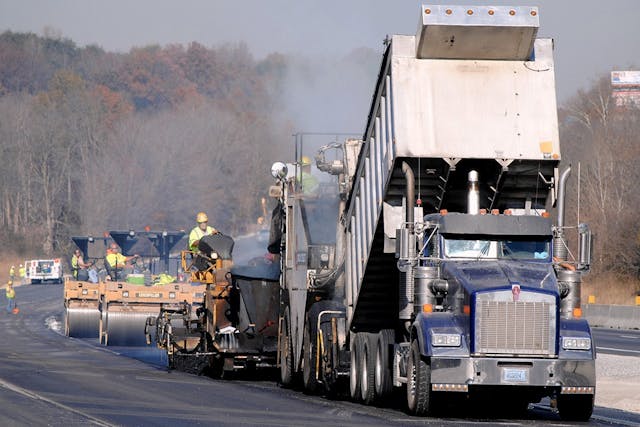Hot Mix Asphalt Paving: Elevating Commercial Parking Lot Requirements
Hot Mix Asphalt Paving: Elevating Commercial Parking Lot Requirements
Blog Article
Opening the Keys of Warm Mix Asphalt Modern Technology
Checking out the depths of hot mix asphalt technology uncovers a world where specific formulations and thorough processes converge to form our roadways and framework. The fusion of aggregates, fillers, and binders isn't simply a building and construction job yet a calculated orchestration of resilience and efficiency. As we peer into the detailed dancing of elements, a tapestry of resilience and sustainability unfolds. However what lies underneath this surface area of asphaltic mastery, and what secrets wait to be introduced in the realm of leading technologies?
Relevance of Warm Mix Asphalt
Hot Mix Asphalt plays a critical duty in modern facilities advancement as a result of its resilience and cost-effectiveness. As one of the most typically made use of paving product for roads, freeways, and car park, Warm Mix Asphalt supplies a variety of advantages that add to its value in building and construction tasks. One essential advantage is its capability to endure rush hour loads and rough weather, providing a reliable and long-lasting surface area for transportation networks. Additionally, Warm Mix Asphalt is affordable in both preliminary construction and lasting upkeep, making it a favored choice for lots of framework jobs.
The resilience of Warm Mix Asphalt stems from its structure, which includes accumulations, binder, and filler materials that are meticulously picked and blended to satisfy details performance demands. On the whole, the relevance of Hot Mix Asphalt in facilities development can not be understated, as it proceeds to be a keystone of contemporary building and construction practices.
Parts of Asphalt Mixes
The structure of asphalt mixes consists of meticulously picked aggregates, binder, and filler materials that are crucial for attaining details performance needs. Aggregates are the main part of asphalt mixes, supplying toughness and security. The binder, generally bitumen or asphalt cement, holds the accumulations with each other and offers adaptability and resilience to the mix.
The mix and percentage of these components play a considerable duty in determining the top quality and performance of the asphalt mix. Engineers very carefully design the mix to satisfy specific requirements, considering elements like website traffic quantity, climate problems, and pavement life expectancy. Correct selection and balancing of accumulations, binder, and fillers are vital for producing sturdy, lasting asphalt pavements.
Combining and Manufacturing Methods

Once the accumulations are chosen, the binder, frequently asphalt cement, is included in bind the materials together. The binder's top quality and quantity considerably influence the mix's stamina, resistance, and adaptability to ecological factors. Furthermore, fillers like hydrated lime or Rose you can look here city cement might be integrated to enhance details characteristics of the asphalt mix, such as its workability or moisture resistance.
Throughout manufacturing, the accumulations and binder are heated, generally in between 250-325 ° F(121-163 ° C ), to help with mixing and ensure correct finishing of the aggregates. The blending process must be thorough to accomplish a homogeneous combination that advertises the desired performance attributes of the asphalt. Different strategies, such as batch blending or drum mixing, are used to accomplish regular and top quality asphalt blends for construction tasks.
Variables Impacting Asphalt Performance
Aspects influencing asphalt Check This Out efficiency incorporate a variety of variables that influence the resilience, longevity, and general high quality of asphalt sidewalks. One key aspect is the top quality of products used in the asphalt mix.

Design factors to consider, such as pavement thickness and drain, are vital in guaranteeing the lasting efficiency of the asphalt pavement. By carefully thinking about these professionals, aspects and designers can maximize asphalt performance and boost the solution life of sidewalks.
Lasting Practices in Asphalt Modern Technology
Additionally, the development of warm-mix read here asphalt (WMA) modern technologies has gotten traction over the last few years. WMA permits for the production and positioning of asphalt mixes at reduced temperature levels contrasted to conventional hot-mix asphalt, leading to minimized power consumption and greenhouse gas discharges. Additionally, using permeable asphalt blends can help reduce stormwater drainage concerns by allowing water to penetrate with the sidewalk and right into the ground, promoting all-natural water filtering and recharge procedures. By executing these sustainable methods, the asphalt sector can add to constructing an extra resistant and eco friendly facilities network.
Conclusion
To conclude, hot mix asphalt modern technology plays a critical duty in modern infrastructure advancement as a result of its resilience and cost-effectiveness. By carefully stabilizing elements, using proper mixing strategies, and taking into consideration different elements, engineers can develop high-grade asphalt mixes that withstand rush hour lots and harsh weather. Accepting sustainable methods, such as utilizing recycled materials and warm-mix technologies, further boosts the environmental friendliness of asphalt technology.
Mixing and manufacturing strategies in warm mix asphalt technology involve the precise combination and handling of aggregates, binder, and fillers to produce a high-performance and long lasting asphalt mix.Factors influencing asphalt performance encompass a range of variables that influence the sturdiness, longevity, and overall high quality of asphalt sidewalks. Lasting methods in asphalt technology incorporate different initiatives intended at decreasing the ecological influence of asphalt production and paving procedures. By incorporating recovered asphalt pavement (RAP) and recycled asphalt tiles (RAS) into new asphalt mixes, the market can considerably minimize the consumption of raw materials and power, while likewise reducing land fill waste.
WMA allows for the production and placement of asphalt mixes at reduced temperatures contrasted to traditional hot-mix asphalt, resulting in lowered energy intake and greenhouse gas emissions.
Report this page